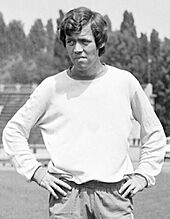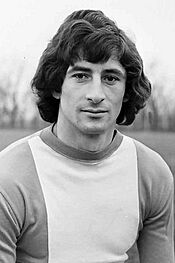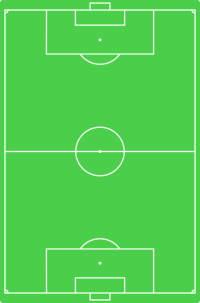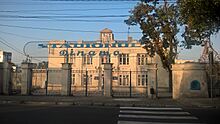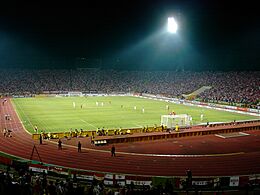FC Dinamo București facts for kids
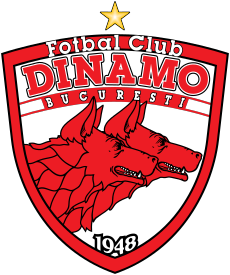 |
||||
| Full name | SC Dinamo 1948 SA | |||
|---|---|---|---|---|
| Nickname(s) |
|
|||
| Short name | Dinamo | |||
| Founded | 14 May 1948 | |||
| Ground | Arcul de Triumf | |||
| Capacity | 8,207 | |||
| Owners | Red&White Management (80.77%) DDB Supporters Association (12.06%) Asociația Clubul Sportiv Fotbal Club Dinamo București (7.03%) Dinamo Socios (0.03%) Lotus Perfect Products SRL (0.01%) |
|||
| Chairman | Andrei Nicolescu | |||
| Head coach | Željko Kopić | |||
| League | Liga I | |||
| 2023–24 | Liga I, 13th of 16 | |||
|
||||
FC Dinamo București, commonly known as Dinamo București (Romanian pronunciation: [diˈnamo bukuˈreʃtʲ]) or simply Dinamo, is a Romanian professional football club based in Bucharest that competes in the Liga I.
Founded in 1948 as the team of the Ministry of Internal Affairs, following the merger of Unirea Tricolor and Ciocanul, Dinamo București has spent all but one year of its history in the top tier of the Romanian league system. Domestically, it is one of the two most successful teams in the country, having won 18 Liga I titles, 13 Cupa României, two Supercupa României, and one Cupa Ligii. In the 1983–84 season, Dinamo became the first club in Romania to reach the semi-finals of the European Cup, being eliminated by Liverpool 1–3 on aggregate.
Dinamo București's traditional home colours are white and red, while the current crest is a modified version of the one adopted in the 1998. Its home venue is the namesake Stadionul Dinamo, although significant matches have also been played at Arena Națională. The team temporarily plays its home fixtures at Stadionul Arcul de Triumf, as its home ground undergoes demolition. Its bitter rivals are neighbouring FC Steaua București, with the match being commonly referred to as "the Eternal Derby, while notable rivalries against Rapid București and Universitatea Craiova also exist.
Contents
History
1948–1955: Foundation and early years
On 14 May 1948, "Unirea Tricolor MAI" — newly entered, in January 1948, under the umbrella of the Communist regime's Internal Affairs Ministry — merged with "Ciocanul București" and formed "Dinamo București", the sporting club representing the above-mentioned institution. The people who contributed at the foundation of the club were the Minister of Internal Affairs, Teohari Georgescu and the Jewish brothers Alexandru and Turi Vogl.
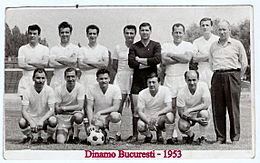
Until the end of the championship, Dinamo was going to be represented by two teams: "Ciocanul" ("Hammer"), named "Dinamo A" and "Unirea Tricolor MAI", known as "Dinamo B" (this last one relegating, at the end of the football season, into the Divizia B). Starting with 1950, Dinamo A was separated from Dinamo B, the latter being transferred first to Braşov, then to Cluj-Napoca, and eventually, in 1958, being moved to Bacău, where it became FCM Bacău.
The "Dinamo" name was used for the first time on 1 May 1948. Nevertheless, the real debut of Dinamo was on the 1947–48 Divizia A edition (finishing 8th). Some of the team's players were Ambru, Angelo Niculescu, Teodorescu, Șiclovan, Bartha, Sârbu. On 14 July 1948 Dinamo played its first international match against Zidnice (Czechoslovakia): 4 to 1 for the red-whites. 22 August will remain a reference date for Dinamo's football, representing the debut of Dinamo Bucharest in the first national Division. The pioneers were, among others, Titus Ozon, Lăzăreanu, Farkaș. The team's first coach was Coloman Braun-Bogdan. At the end of the '48–'49 edition, Angelo Niculescu retires, dedicating himself to the coaching career rewarded later with great victories with Dinamo and with the national team. In 1950, new football players arrived at Dinamo: Nicolae Dumitru, Băcuț I.
In 1955, Dinamo won their first championship. With Angelo Niculescu as head coach, Dinamo impressed mainly in the offensive, with an attack formed by Ene I, Neagu and Suru. The defense, with players like Băcuț I, Băcuț II, Szökő, Călinoiu, was the best in the championship – only 19 goals received.
In the fall of 1956, the team make its debut in the European Champion Clubs' Cup (competition created a year before). Dinamo was the first Romanian team to play in the continent-wide competitions. The debut game was played on 26 August 1956, in front of 32,000 spectators. Dinamo defeated Galatasaray with 3–1. In the second leg, Dinamo lost in Istanbul with 1–2, and moved forward.
1950–1981: European successes
Dinamo won the second championship in 1962, with players like Datcu, Ștefan, Unguroiu (head coaches were Nicușor Dumitru și Nedelescu). In 1963, Dinamo won their third title. The team brought in that season Pârcălab, Gergely (Tr. Ionescu – Nicușor Dumitru were the head coaches). Dinamo won also the Romanian Cup in 1964, 5–3 against their biggest rival Steaua. Dinamo played in the European Cup against the famous Real Madrid (1–3 in București), a team with Di Stefano and Gento. The game played in Bucharest took place at "23 August" Stadium, and established a new record for this arena: 100,000 spectators.
In the fall of 1964, in the European Cup, Dinamo met another famous team – Inter Milan – with Facchetti, Picchi, Jair, Mazzolla, Corso and Suarez. Dinamo lost both legs, 0–6 and 0–1. In 1965, Dinamo won another championship and brought new players, Mircea Lucescu and Grozea. The following season of the European Cup, Dinamo met again Inter Milano, and managed to win the home game, 2–1. Inter won at Milano 2–0 and moved forward.
The 6th title: in 1971. In CCE, Dinamo eliminates Spartak Trnava, the team of Dobias, Kuna and Adamec. A new player: Florea Dumitrache. What follows is a double win against Israel's and Van Hanegem's Feyenoord: 0–3 and 0–2. The 7th title comes two years later, in 1973, when Dinamo won a game against CFR Cluj at the exact margins to pass Universitatea Craiova in the standings. In CCE, they surpass Northern Ireland's Crusaders Belfast ( The 11–0 home game against Northern Ireland's team is still the biggest margin of victory in the history of the European Cup ), but fail against Atlético Madrid (0–2 and 2–2), the team of Capon, Irueta, Heredia and Ayala. The next year Dinamo plays in the UEFA Cup and after the eliminating Bolospur, fails in the confrontation with F.C. Koln: 1–1 and 2–3!
The 8th big success was going to come in 1975, year when Dudu Georgescu receives "the golden boot" (with 32 goals). In '76 in the UEFA Cup Dinamo plays against another "sacred monster" – AC Milan – with Fabio Capello and Collovatti on its side: 0–0 and 1–2. The 1976–1977 first season brings the 9th title and a new golden boot for Dudu Georgescu (47 goals). In the autumn of '77 in the CCE, Dinamo wins a thrilling game against Atlético Madrid 2–1, but loses at Madrid, 2–0.
In the second round of the UEFA Cup (after eliminating Alki Larnaca from Cyprus) Dinamo is eliminated by Eintracht Frankfurt, team of Pezzey, Grabowsky and Holzenbein (2–0 and 0–3 in prolongation).
1981–1992: Golden team
The 1981–82 UEFA Cup season brings some great wins for Dinamo. The red-whites meet Levski Sofia, team of Sirakov and Iskrenov (3–0 and 1–2). In the second round, a terrifying "double": Dinamo-Internazionale (with Bergomi, Bagni, Prohaska, Altobelli, Baresi, Oriali, Marini and Beccalossi). At Milan, 1–1 (authors: Pasinato and Custov) and back home in Bucharest, 3–2 for the "dogs", in the extra time. Dinamo is eliminated by the Swedish team IFK Göteborg, which later ends up winning the trophy.
The 10th national title will be obtained in 1982, when Dinamo also conquers the Cup after a 3–2 victory against Baia Mare. After a 5-year absence, Dinamo reappears in the European Champions Cup, meeting (and eliminating) Vaaleregen Oslo. In the next stage, Dinamo had to confront a difficult opponent: the team of Vizek and Nehoda, Dukla Prague. They win at home, with 2–0, obtaining the qualification at Prague: 1–2. Dinamo is eliminated by Aston Villa, club of Bremmer, Cowans, Withe, Shaw and Morley. The 11th title come one year later, in 1983.
The 1983–1984 season began with the retirement of Cornel Dinu, winner of 6 national titles and 6 national cups, with 454 caps in the first league and 75 in the national team. Still the same year Dinamo wins the 12th title. The autumn of 1983–84 was going to represent a valuable step into the international arena. The "European Champions Cup campaign" started with the Finnish team, Kuusysi Lahti (1–0 and 3–0). The second round pushes Dinamo against the current champion, Hamburger SV – team of Stein, Kalz and Magath. At Bucharest, Augustin, Mulțescu and Orac score for 3–0. The thrilling second leg finishes 3–2 (goals Țălnar and Mulțescu). In order to accede in the semifinals of CCE, Dinamo had to defeat another top team: Dinamo Minsk, with Aleinikov, Zigmanatovici and Gurinovici. The first leg was 1–1 (Rednic equalizing in the 87th minute), and it was followed by a 1–0 victory at Bucharest (with Augustin scoring). Dinamo was the first Romanian team to reach the European Champions Cup semi-finals, where it met Liverpool. Dinamo lost 1–0 at Anfield in the first leg match where Graeme Souness had punched captain Lica Movila which had set up a tough match back in Romania. In the second-leg Bucharest lost 2–1 to Liverpool who went on to win the competition. In the first round of the next European Champions Cup, in the autumn of `84, Dinamo meets Omonia Nicosia: 4–1 and 1–2. Next is the match against Girondins Bordeaux (club of Tigana, Giresse, Lacombe and Battiston), Dinamo being eliminated after 0–1 and 1–1. In 1986, Dinamo won the Cup against Steaua (1–0). After an 18-year break, Dinamo played again in the Cup Winners Cup in the autumn of 1986. The 1986–87 season brought the 'golden boot' for Cămătaru (44 goals). They also lost against the Albanian team 17 Nentori Tirana. The 1988 Romanian cup final was a special one. After Steaua players left the field at the score of 1–1 due to a claim of being robbed by the referee, Dinamo was given the trophy, but later the Romanian F.A. (bowing to pressure from the Communist Party) awarded the match 2–1 to Steaua. After the revolution of December 1989, Steaua propositioned to return the trophy to Dinamo, which refused to take it. In the 1988–89 Cup Winners Cup season, Dinamo again eliminated the Finnish team Lahti, managing to win 3–0. Next is the elimination of
Scottish club Dundee United: 1–0 and 1–1 at Bucharest. However, they fail to qualify for the semifinals after losing on away goals, 1–1 and 0–0 against Sampdoria Genova.
The Cup Winners Cup 1989–90 season brings new success. Dinamo meets Albanian team, Dinamo Tirana 0–1 and 2–0. Next is the Greek champion, Panathinaikos 2–0 and 6–1. In the quarter-finals they meet Partizan Belgrade (with Mijatovici on the field) eliminating them with 2–1 and 2–0. After six years of break, Dinamo plays a new continental semifinal this time against Anderlecht Bruxelles, losing twice with 1–0. In the summer of 1990, Dinamo – with Mircea Lucescu as coach – conquers a new national title, the 13th. Also the team wins the Cup final, against Steaua: 6–4. The new CCE season begins with the elimination of Irish team St Patrick's Athletic Dublin (4–0 and 1–1). Dinamo is eliminated in the second round by FC Porto. The 1991–92 UEFA Cup Edition faces Dinamo against Figo's Sporting Clube de Portugal, qualifying after a 0–1 loss and a 2–0 victory. The next round Dinamo is eliminated by Genoa 1893: 1–3 and 2–2. In 1992, the 14th title was added to Dinamo's record. It was a triumphal march, with 34 matches and no defeat.
1992–2013: Ups and downs
The years to come saw Dinamo in the UEFA Cup. However, without any special results, the team leaves the competition in the first qualification round, in 1993–1994 losing to Cagliari, in 1994–95 losing to Trabzonspor, and in 1996 losing to Levski Sofia.
Among the new players that play for Dinamo are: Catalin Hildan, Florentin Petre, Cosmin Contra. Alongside the famous goalkeeper Florin Prunea appear Mihalcea and Kiriță. With this new team, in the 1998–1999 season Dinamo plays arguably the best football in Romania, though the team loses the title to Rapid București. Dinamo ended the dark era of the mid-1990s this way once they started to fight for the title this year, only having to wait one more year to win it with no contender. Dinamo played next season in the UEFA Cup beating Benfica 1–0 on Estádio da Luz, then losing a suspected game on Lia Manoliu 2–0. Dinamo won the title in the 1999–2000 with Adrian Mutu playing for them but lost to Polonia Warszawa in the second qualification round of the UEFA Champions League 1999–00 mostly because they sold most of the players in the Summer Mercato. This affected their next season, when they lost the title to Steaua Bucharest. In 2001–02 Dinamo won the title again after a tight championship run. Dinamo managed to win the title in the last game of the season just in front of FC National. In Europe, Dinamo played in the 2001–02 UEFA Cup eliminating Dinamo Tirana in the Qualifying round but lost in the 1st round to Grasshopper Club Zurich. In the 2002–03 season Dinamo was affected again by the players who left the team, with it becoming a tradition for the leaders of the club to sell players after winning a title, losing the games in the UEFA Champions League and having a hard time in Divizia A. Dinamo changed a lot of managers and lost 7 consecutive games. After Ioan Andone came to the team, Dinamo played a spectacular semifinal with Astra Ploiesti. After losing 2–1 in Ploiesti in the middle of the crisis the team beat Astra in Bucharest 3–1 after extra time. They then went on to win the Romanian Cup, after beating FC National in the final 1–0 on a goal scored by Iulian Tames.
After building up a team again in 2003–04, they eliminated Shakhtar Donetsk in the first round of the UEFA Cup 2003–04 season. They went on to lose to Spartak Moscow in the second round. In the Romanian League Dinamo won the title by defeating FCSB in a close battle. They also won the Romanian Cup after a 2–0 win over Oţelul Galaţi at Cotroceni.
For the 2004–05 season Dinamo played a thrilling game vs. Manchester United in Bucharest, at the National Stadium, in the third qualification round of the UEFA Champions League, but lost 1–2. This game was significant because it showed a lot of progress from the last attempts to qualify for the group phase of the Champions League. The 2nd leg was lost at Old Trafford 3–0.
A highlight in recent times came in the UEFA Cup 2005-06 season when Dinamo thrashed Premier League team Everton 5–1. Dinamo went on to win the tie 5–2. Also, they managed to beat CSKA Moscow (Cup Holders) 1–0 but they missed the European Spring due to a couple of close games lost in the last few seconds. The most controversial was played at Stade Vélodrome, where Dinamo lost 2–1 against Olympique de Marseille although Octavian Chihaia scored the equalizer in the dying seconds, but the referee didn't validate the goal because he was turn towards the center of the field, preparing to end the game.
In the 2006–07 season they did qualify for the European Spring where they were eliminated by Benfica after a 0–1 loss at Da Luz and a 1–2 loss at home. Domestically, the team crushed most of its opponents in the first 19 rounds, ending up autumn champions, 13 points ahead of second place and then they secured their 18th title with four rounds to spare. The Romanian champions could have qualified directly to the Champions League group stage for the 2007–08 season, if Manchester United or Chelsea would have won the competition in the 2006–07 season. But AC Milan became champions, and Dinamo had to play a preliminary round before the group phase.
Dinamo failed again to enter the Champions League group phase, being eliminated in the third qualifying round by Lazio Roma. After four manager changes, Dinamo finished the 2007–08 season on the 4th spot in Liga I. In the summer of 2008, Mircea Rednic returned as coach having the mission to win the title and qualify Dinamo to the Champions League, but after the team finished the first part of the season as leader, they failed at the finish line and ended only third.
In the 2009–10 season, Dinamo played in the playoff for Europa League against Czech football club FC Slovan Liberec. In the first leg the supporters invaded the pitch causing the match to be abandoned in the 88th minute when the score was 2–0 for Slovan. The UEFA Control and Disciplinary Body awarded a default 0–3 defeat against Dinamo. One week later in Liberec Dinamo managed a memorable comeback and qualified in the Europa League 2009–10 group stage after winning 3–0 in Liberec after 90 and 120 minutes and winning 9–8 at penalties after 10 series. The domestic season was yet another unsuccessful one, finishing 6th in the championships.
Dinamo finished 6th in the 2010–11 season and qualified for the Cup finals against FCSB, but lost due to an own goal. For the 2011–12 season, club started with a new coach, ex-Dinamo player Liviu Ciobotariu.
After a disappointing defeat against Vorskla Poltava in the Europa League Play-Off, Dinamo is leading the Romanian Championship after 10 rounds with the best offense and defense in the championship despite selling Gabriel Torje to the Italian team Udinese with only Dorel Stoica and Srdjan Luchin completing the squad for the new season.
At the end of the autumn season, Dinamo was leading the table by one point ahead of CFR Cluj and started the spring one with a 2–0 win against Gaz Metan Mediaș in the first ever game played by the Red Dogs on the Național Arena in front of a season record of 20,000 spectators that filled the first tier of the brand new stadium. Even in this circumstances, the team had a very disappointing spring run in the league and finished 5th, with 62 points in 34 matches. Still, Dinamo managed to win 2 trophies, the Romanian Cup, in a final against Rapid, qualifying in the process for the Europa League Play-off and the Romanian Super Cup against CFR Cluj.
2013–2017: Changing of ownership and insolvency
In March 2013, businessman Ionuț Negoiță bought the club from Nicolae Badea. The 2012–13 season ended with the same team as before the changing of the ownership, but after the season, Negoiță started his moves. He appointed former Dinamo glory Gheorghe Mulțescu as head coach, bought a new president, Constantin Anghelache and a new boss for the youth academy, Gabi Răduță. Things didn't work as hoped and in September 2013, Mulțescu was sacked. The decision came because Dinamo won only nine points in the first eight rounds of the Liga I season. Mulțescu's replacement was Flavius Stoican who was promoted from the second team. With Stoican at helm, Dinamo started to climb and in March 2014, the team was close to the podium. They finished the season on the fourth spot and reached the semifinals of the Romanian Cup, where they were ousted by FCSB.
In May 2014, Ionuț Negoiță announced that the club began the procedures to enter the insolvency. The Bucharest Court accepted the request in June 2014. Thus, the Licence Committee from the Romanian Federation decided to withdraw Dinamo's rights to enter the Europa League. On 24 September 2015, the Bucharest Municipal Court ruled that Dinamo met the criteria to end the insolvency process. But the club wasn't able to enter the European competitions, thus, despite ending the season on the 4th position, Dinamo didn't participate in the Europa League. In the 2016–17 Liga I season, Dinamo finished third in the play-off and qualified for the Europa League. In the 2017–18 UEFA Europa League season, Dinamo met the Spanish club Athletic Bilbao, in the third qualifying round. The first match, in Bucharest, ended 1-1, with the Brazilian Rivaldinho scoring for Dinamo. But Athletic won the second match 3-0 and Dinamo was eliminated. The following two seasons in Liga I, Dinamo failed to qualify for the play-off and missed the European cups.
2017–present: Troubled times
Dinamo failed to reach the play-offs for three consecutive seasons (2018 to 2020) and with each season ended in a lower tier than before. After the ninth place in 2019, Dinamo entered the battle against relegation in the 2019–20 Liga I season. The owner, Ionuț Negoiță, wanted to sell the club, but nobody came with a serious proposal and the fans association bought 20% of the club's shares. Adrian Mihalcea was named head-coach in March 2020, but made his debut in June, after the COVID-19 lockdown ended. Mihalcea began his tenure with four losses in the first four games in charge and Dinamo reached bottom in the championship. On 5 July, Dinamo won against Academica Clinceni and hauled themselves off the bottom position but stayed in the relegation zone. The next game ended in a draw, at home, against Politehnica Iași. Thus, Mihalcea was sacked, after only seven games in charge. Gheorghe Mulțescu came back as Dinamo's head coach, for the fourth time.
On 6 August, the Liga I season was frozen and Dinamo didn't play all its postponed games, finishing the season in 13th place. But the club was spared from relegation after the Romanian Federation decided to increase the number of teams in Liga I from 14 to 16. Thus, only the 14th place played a relegation/promotion play-off against the third place in Liga II.
On 13 August 2020, the club was purchased by Benel International SA, a Spanish company represented by Pablo Cortacero. Dinamo transferred several contract-free players with impressive resumes and big salaries. Cosmin Contra came as head coach and footballers like Borja Valle, Aleix Garcia, and Juan Camara arrived with salaries of up to 33,000 euros per month. But Dinamo had a poor start of the season and the new owner, Pablo Cortacero, did not transfer any money to the players for several months. Almost all the foreign players submitted their memoirs so that they could leave free. Dinamo was left with huge debts, of approximately 7 million euros, and at the beginning of the 2021–22 season, the club went into insolvency again. The 2021–22 season ended with a relegation to Liga II. Dinamo ended 14th the regular season and the play-out, then played the promotion/relegation play-off against Universitatea Cluj, third place in Liga II. U.Cluj won the first match, 2–0 at Cluj Arena. The second leg, at Dinamo stadium, ended 1–1. Thus, Dinamo Bucharest relegated for the first time in its history.
In March 2022, the businessman Dorin Șerdean became the majority shareholder of Dinamo after an agreement to take over the club from Pablo Cortacero. In February 2023, Şerdean accepted the offer received from the Red&White company to sell the club. The owners of Red&White are Andrei Nicolescu, who owns 60% of the company, and Eugen Voicu, who owns 40%. The administrator of Red&White is Eugen Voicu. During the promotion play-off, Dinamo defeated Argeș Pitești with a whopping 6–1, before they lost 4–2 in the second leg, a record breaking play-off with loads of goals, 8–5 in aggregate, which took Dinamo back to the Liga I after just one season of staying in Liga II.
Crest and colours
Dinamo's colours are red and white. The current crest includes the profile of two red dogs and also a gold star above them, representing the club's tenth league title.
Stadium
Dinamo plays its home games at Stadionul Dinamo. The current Dinamo Stadium was inaugurated on 14 October 1951. The first match: Dinamo-Locomotiva Timişoara 1–0. The stadium capacity was planned at 16,000, but the installation of seats decreased it to 15,032. The stadium is part of a larger complex which contains a smaller stadium, Stadionul Florea Dumitrache, where the second team, Dinamo II, would play its matches. It is currently used by CS Dinamo București rugby team. There is also a sports hall and a swimming pool.
The stadium is referred to as "Groapa" (The Pit), as it was dug rather than raising stands. The North stand is named Peluza Cătălin Hîldan, in the honor of a former Dinamo player who died in 2000 at the age of 24.
Dinamo plays significant matches, such as against rivals FCSB, at Arena Națională. From 2022 onward, the team plays its home matches at the newly built Stadionul Arcul de Triumf, as its traditional ground does not meet the requirements for first league games.
Support
Dinamo has an estimated 13% support in Romania, making them the second most supported Romanian club, after FCSB. The largest concentration of fans is in Bucharest, mainly in the northeast and central areas of the city. The club also has important fan bases on other parts of the country and where significant bases of Romanians are found.
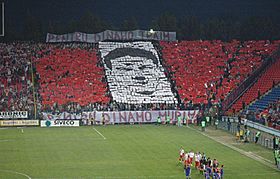
The roots of the Dinamo ultras (fans) movement can be found in 1995 when groups like Dracula and Rams Pantelimon appeared in the North End. In 1996 a group called Nuova Guardia was formed, and became the leading group in the stadium and later on in the entire Romanian ultras movement. Following the death of the former captain, Cătălin Hîldan, in 2000, the fans renamed the North End of Dinamo's stadium to Peluza Catalin Hîldan (PCH Stand) in his honor. The majority of supporters are located in the PCH, but several factions have moved to the South End.
Rivalries & Friendships
Dinamo's significant rivalry is with FCSB, with matches between them dubbed the Eternal derby. Both clubs have had the most popularity in Romania with as strong reactions from its respective fans in clashes in the stadium during games and elsewhere. In 1997, Dinamo's fans set a sector of the Stadionul Ghencea on fire. On 16 August 2016, during FCSB's UEFA Champions League 0–5 play-off loss against Manchester City, Dinamo fans unveiled a banner that read Doar Dinamo București ("Only Dinamo Bucharest").
The club's second most important rivalry is against Rapid București. In the 1990s, there was fierce competition between the two in winning the championship title.
Another rivalry is held against Universitatea Craiova; both finished with the same number of points in the 1972–73 Divizia A, but Dinamo was given the title because of their superior goal difference. A conflict has existed ever since. Other smaller rivalries exist, such as the one against Petrolul Ploiești.
Dinamo's fans have a good friendship with Universitatea Cluj's fans. The friendship started in the mid-1990s, both ultras groups being linked with "the mentality, fanaticism and nationalist side" and the common hate for FCSB. Dinamo have unofficial friendship with Crvena Zvezda, famous Serbian club. Friendship between this two clubs, are based on Orthodox Christianity same religion.
Youth program
Dinamo has an important infrastructure for training professionalism in the sport and developing interest in the youth area. The youth center organises a system based on nine age groups between nine and 18 years. Dinamo has around 180 juniors.
All the groups play in the competitions organised by the Bucharest Football Association and in those created by the Romanian Federation. Youths around 16–18 years old are promoted to the second team, Dinamo II.
The youth center has its base in the Dinamo Sports Center, where they have eight dressing rooms for the players, one for the coaches, one for the referees, a medical center and a store room for the equipment. Also, the center has many training grounds, among them the Piți Varga field.
Honours
Domestic
Leagues
- Liga I
- Winners (18): 1955, 1961–62, 1962–63, 1963–64, 1964–65, 1970–71, 1972–73, 1974–75, 1976–77, 1981–82, 1982–83, 1983–84, 1989–90, 1991–92, 1999–2000, 2001–02, 2003–04, 2006–07
- Runners-up (20): 1951, 1952, 1953, 1956, 1958–59, 1960–61, 1966–67, 1968–69, 1973–74, 1975–76, 1978–79, 1980–81, 1984–85, 1986–87, 1987–88, 1988–89, 1992–93, 1998–99, 2000–01, 2004–05
Cups
- Cupa României
- Winners (13): 1958–59, 1963–64, 1967–68, 1981–82, 1983–84, 1985–86, 1989–90, 1999–2000, 2000–01, 2002–03, 2003–04, 2004–05, 2011–12
- Runners-up (10): 1954, 1968–69, 1969–70, 1970–71, 1986–87, 1987–88, 1988–89, 2001–02, 2010–11, 2015–16
- Cupa Ligii
- Winners (1): 2016–17
- Supercupa României
- Winners (2): 2005, 2012
- Runners-up (4): 2001, 2002, 2003, 2007
Continental
- European Cup
- Semi-finalists (1): 1983–84
- Cup Winners' Cup
- Semi-finalists (1): 1989–90
Players
First-team squad
|
|
Out on loan
|
|
Retired numbers
|
Club officials
Statistics and records
European cups all-time statistics
Updated 3 August 2017.
| Competition | S | P | W | D | L | GF | GA | GD |
|---|---|---|---|---|---|---|---|---|
| UEFA Champions League / European Cup | 18 | 66 | 24 | 10 | 32 | 96 | 106 | –10 |
| UEFA Cup Winners' Cup / European Cup Winners' Cup | 5 | 20 | 8 | 4 | 8 | 25 | 18 | +7 |
| UEFA Europa League / UEFA Cup | 23 | 90 | 37 | 14 | 39 | 147 | 127 | +20 |
| UEFA Intertoto Cup | 1 | 4 | 1 | 0 | 3 | 4 | 6 | –2 |
| Total | 47 | 180 | 70 | 28 | 82 | 272 | 257 | +15 |
Records in the league:
- Consecutive winning games: 17 games (12 June 1988 – 27 November 1988)
- Best unbeaten run: 47 games (26 May 1991 – 20 September 1992)
- Player with most appearances:
 Cornel Dinu (454)
Cornel Dinu (454) - Top scorer:
 Dudu Georgescu (207)
Dudu Georgescu (207) - Player with most appearances in international games:
 Claudiu Niculescu (43)
Claudiu Niculescu (43) - Top scorer in international games:
 Claudiu Niculescu (18)
Claudiu Niculescu (18)
Records in the European competition:
- Biggest home win: Dinamo 11–0
 Crusaders F.C. (1973–74) (still the biggest margin of victory in the history of the European Cup)
Crusaders F.C. (1973–74) (still the biggest margin of victory in the history of the European Cup) - Biggest away win:
 Alki Larnaca F.C. 0–9 Dinamo (1979–80)
Alki Larnaca F.C. 0–9 Dinamo (1979–80) - Heaviest home defeat: Dinamo 0–3
 Feyenoord (1971–72), Dinamo 0–3
Feyenoord (1971–72), Dinamo 0–3  Galatasaray (2009–10)
Galatasaray (2009–10) - Heaviest away defeat:
 PFC CSKA Sofia 8–1 Dinamo (1956–57)
PFC CSKA Sofia 8–1 Dinamo (1956–57)
Notable former players
Dinamo's record appearance-maker is Cornel Dinu, who made 454 appearances between 1966 and 1983. Ionel Dănciulescu has made the second most appearances with 355.
Notable former coaches
Nicolae Dumitru is the most successful head coach in Dinamo's history, with five league titles and two Romanian Cups. Ioan Andone won five trophies for Dinamo, winning one title in Liga I, three Romanian Cups and one Supercup.
See also
 In Spanish: Fotbal Club Dinamo de Bucarest para niños
In Spanish: Fotbal Club Dinamo de Bucarest para niños


